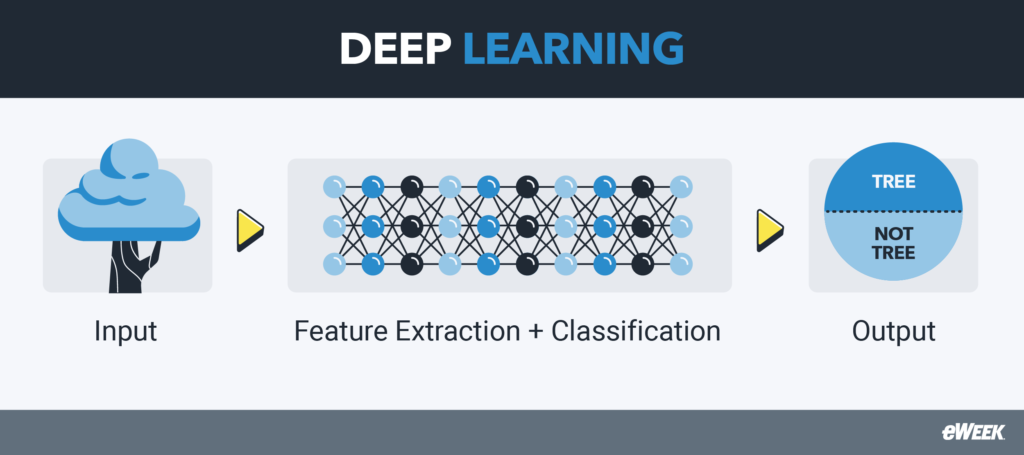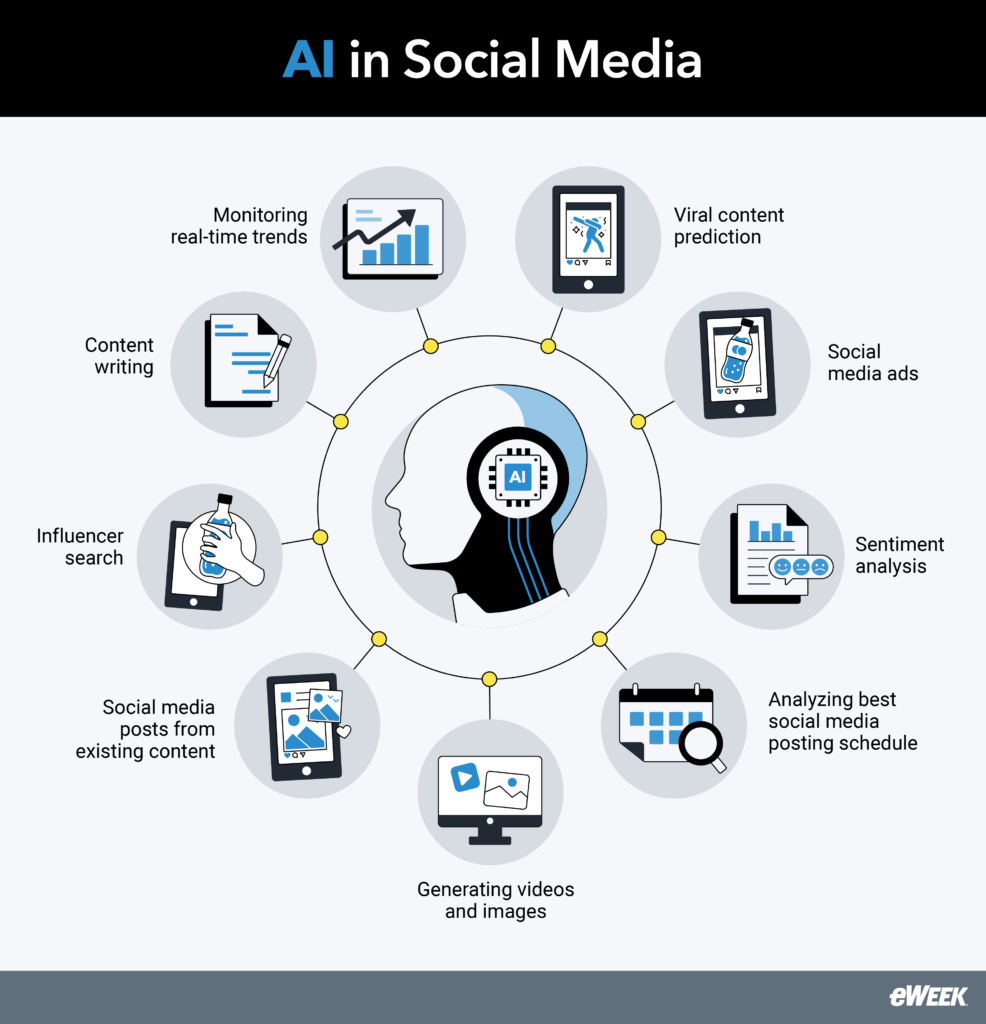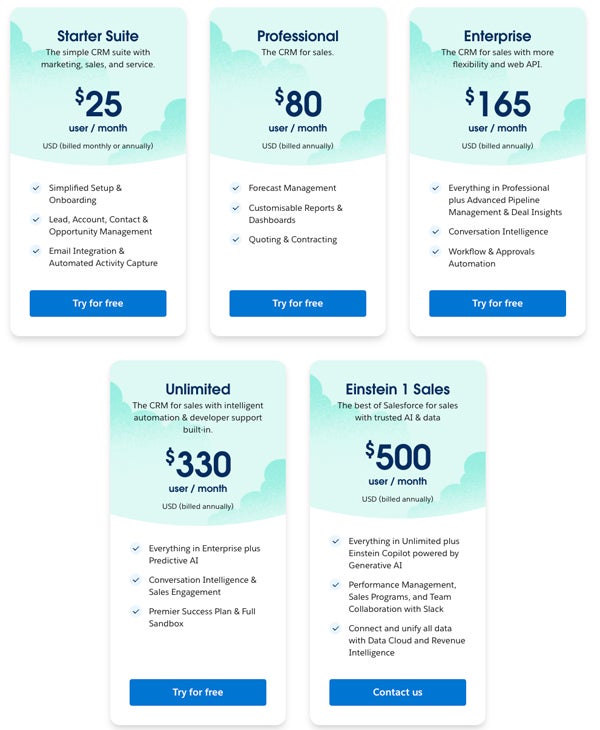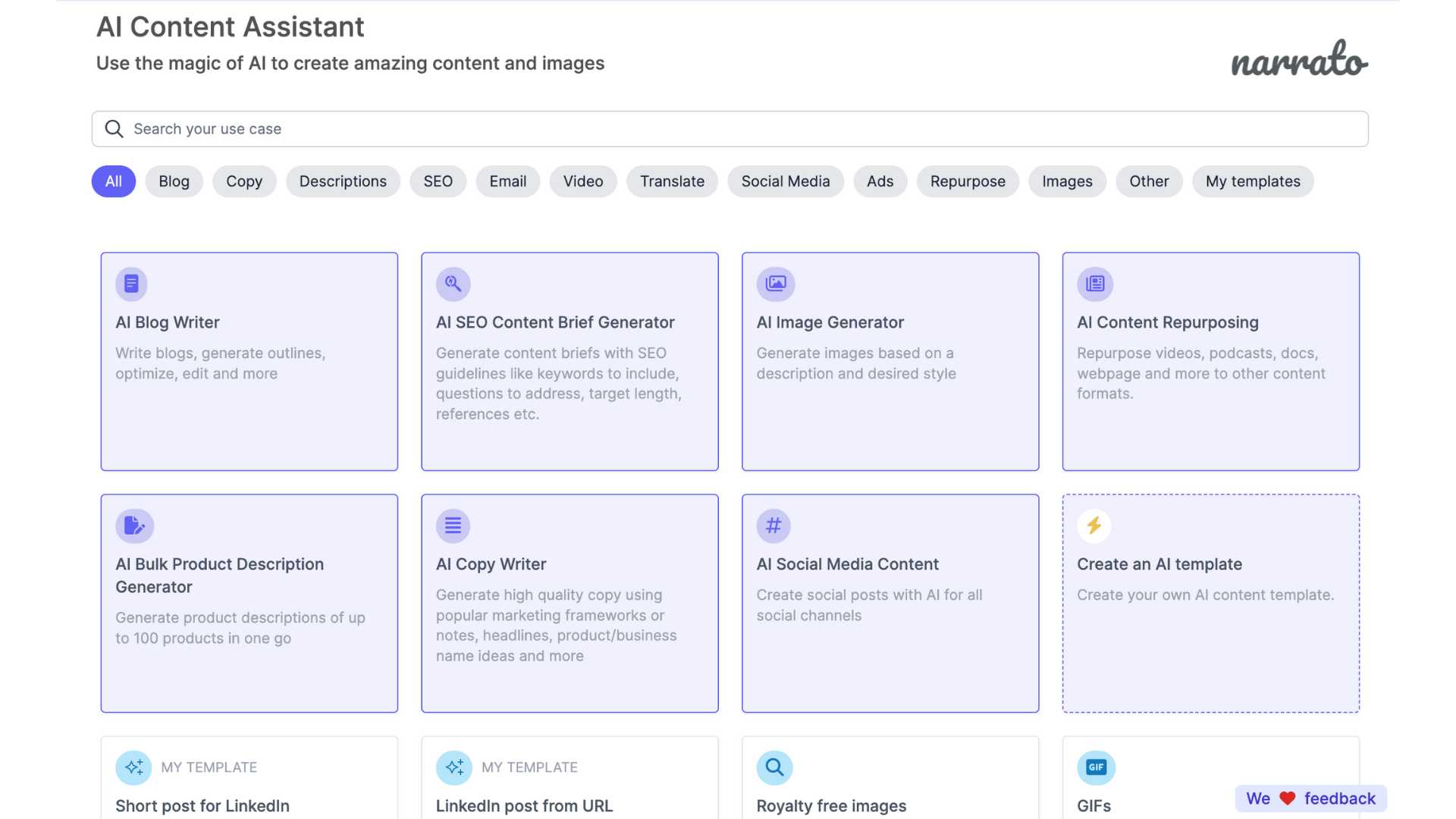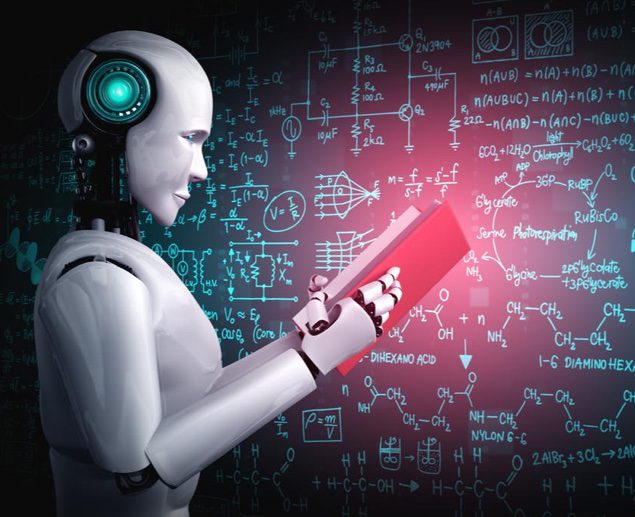Relating to generative AI vs deep studying, there’s numerous buzz… and simply as a lot confusion about these two associated applied sciences and the totally different roles they play. Deep studying and generative AI (GenAI) are each superior AI applied sciences that use neural networks for numerous functions, similar to picture recognition and creation, autonomous transportation, and artistic content material era. More and more, these applied sciences are shaping the world as companies combine them into a variety of merchandise and processes which have the potential to have an effect on our jobs, our sources of knowledge and leisure, our financial system, and extra. Understanding the important thing variations between them is necessary to know the way finest to make use of every of those dynamic applied sciences to achieve a aggressive edge or enhance your corporation.
KEY TAKEAWAYS
- Deep studying focuses on predicting or classifying knowledge, whereas generative AI creates new content material. (Bounce to Part)
- Widespread deep studying strategies embrace CNNs, RNNs, and LSTMs. (Bounce to Part)
- Deep studying gives glorious sample recognition functionality, however wants huge datasets for prime accuracy. (Bounce to Part)
- GenAI makes use of GANs, VAEs, and LLMs to be taught from knowledge. (Bounce to Part)
- Generative AI boosts creativity and content material creation effectivity, however can produce biased outputs, and there are moral considerations round its use. (Bounce to Part)
TABLE OF CONTENTS
Toggle
- Variations Between Deep Studying and Generative AI
- What’s Deep Studying?
- What’s Generative AI?
- 3 Introductory Programs to Be taught Extra
- Backside Line: Selecting Purposes for Deep Studying vs Generative AI
Variations Between Deep Studying and Generative AI
Deep studying and generative AI are two distinct subsets of synthetic intelligence (AI) with totally different approaches, targets, and functions. In a nutshell, deep studying focuses on studying from giant quantities of information with a view to predict or classify one thing. GenAI, alternatively, concentrates on producing new content material that mimics actual knowledge primarily based on patterns in present knowledge.
Deep studying and GenAI even have totally different outputs, strengths, and challenges. The desk under reveals a fast overview of the primary variations between the 2.
Deep Studying Generative AI (GenAI)
Definition
- Subset of machine studying
- Makes use of layers of neural networks to mannequin advanced knowledge patterns
- Subset of deep studying
- Focuses on producing knowledge, similar to textual content, pictures, or audio much like a given dataset
Major Purpose
- To be taught from giant datasets to make predictions or classifications
- To create new and unique content material primarily based on coaching knowledge
Strategies Used
- Convolutional Neural Networks (CNNs)
- Recurrent Neural Networks (RNNs)
- Lengthy Brief-Time period Reminiscence (LSTM)
- Generative Adversarial Networks (GANs)
- Variational Autoencoders (VAEs)
- Giant Language Fashions (LLMs)
Widespread Purposes
- Picture and speech recognition
- Autonomous driving
- Picture creation
- Textual content era
- Chatbots and conversational AI
Knowledge Dependency
- Requires giant units of labeled knowledge for coaching
- Can work with labeled and unlabeled knowledge to generate new outputs
Outputs
- Predictions or classifications primarily based on enter knowledge
- New and unique content material primarily based on realized patterns
Strengths
- Sample recognition
- Automated characteristic extraction
- Steady studying
- Extremely-realistic content material
- Can improve creativity
- Will increase effectivity
Challenges
- Requires huge quantities of datasets
- Computationally intensive
- Overfitting
- Could produce biased or unrealistic outputs
- Moral considerations
- Potential for misuse
What’s Deep Studying?
Deep studying is a department of AI—particularly, a subset of machine studying (ML)—that entails the usage of synthetic neural networks to autonomously be taught advanced patterns and make clever choices throughout numerous domains, together with picture and speech recognition. Giant quantities of labeled knowledge are used to coach deep studying algorithms to attach knowledge options with labels. After coaching, the deep studying mannequin can classify and make predictions on new knowledge enter.
How Does it Work?
The deep studying mannequin processes the enter knowledge by way of layers of interconnected neurons. These neurons then extract more and more advanced options from the enter in a course of often known as characteristic extraction. Characteristic extraction permits the mannequin to acknowledge patterns inside the knowledge and make correct classifications by predicting output primarily based on its coaching knowledge.
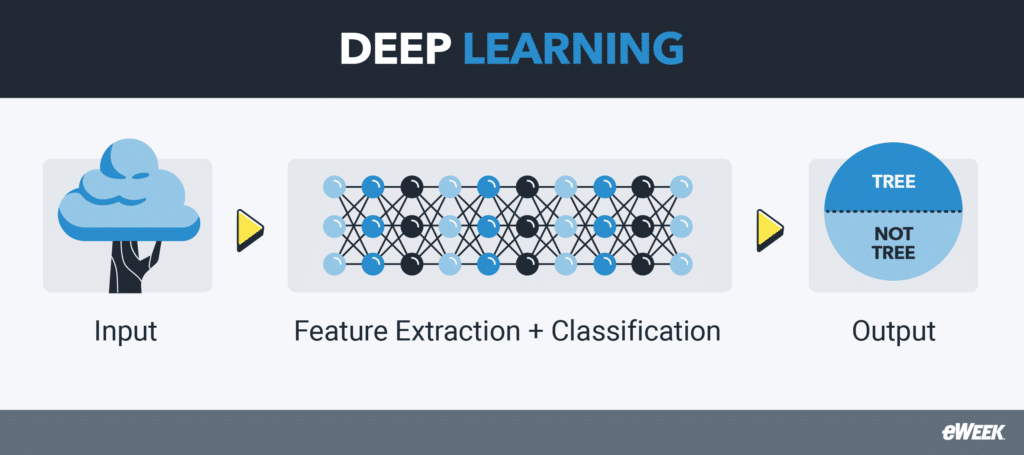 On this instance of the deep studying course of, the consumer uploads an image of a tree within the AI instrument. The deep studying mannequin processes the picture by way of its layers of neurons. Then, the AI mannequin efficiently identifies and classifies the picture, showcasing its means to interpret advanced visible knowledge.
On this instance of the deep studying course of, the consumer uploads an image of a tree within the AI instrument. The deep studying mannequin processes the picture by way of its layers of neurons. Then, the AI mannequin efficiently identifies and classifies the picture, showcasing its means to interpret advanced visible knowledge.
Strategies Utilized in Deep Studying
A number of strategies utilized in deep studying allow AI fashions to hold out advanced duties with excessive precision. These permit neural networks to course of and establish knowledge in numerous kinds, similar to texts and pictures. Listed below are the commonest:
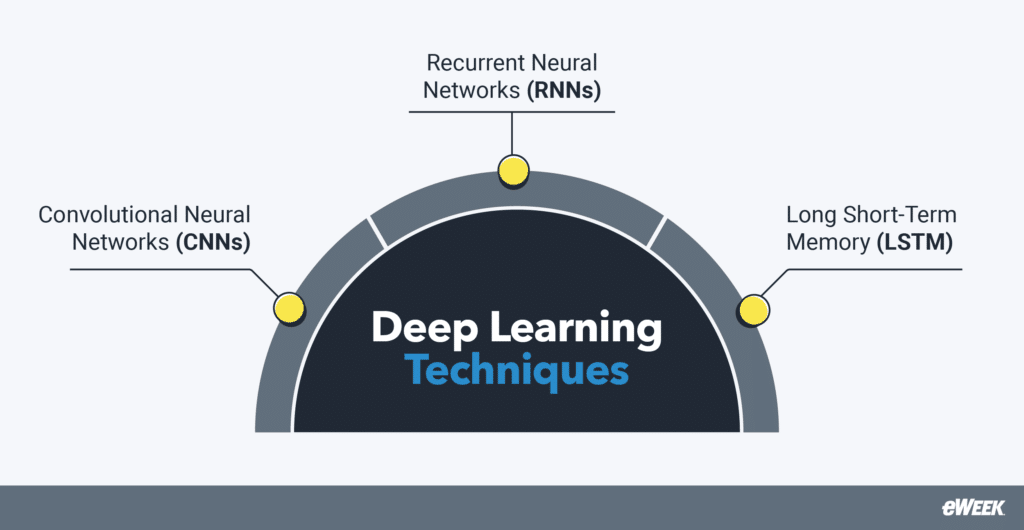 Convolutional neural networks (CNNs), recurrent neural networks (RNNs), and lengthy short-term reminiscence (LSTM) are a number of the widespread deep studying strategies.
Convolutional neural networks (CNNs), recurrent neural networks (RNNs), and lengthy short-term reminiscence (LSTM) are a number of the widespread deep studying strategies.
- Convolutional Neural Networks (CNNs): These specialise in detecting patterns in pictures and extracting related options from them. CNNs use a sequence of layers and a hierarchical construction to course of the picture knowledge with out handbook characteristic engineering. They’re used for picture and object recognition.
- Recurrent Neural Networks (RNNs): Recurrent Neural Networks (RNNs) are designed for dealing with sequential info, like textual content or time sequence. Additionally they bear in mind earlier info to know context whereas processing new ones. RNNs are good for language translation and recognition.
- Lengthy Brief-Time period Reminiscence (LSTM): That is an enhanced kind of RNN that captures long-term dependencies in sequential knowledge. It’s higher at remembering info over lengthy durations than conventional RNNs. LSTM is used for autocomplete and speech recognition.
Deep Studying Purposes
Deep studying helps AI instruments be taught and carry out duties like detecting pictures and objects with excessive accuracy. As deep studying algorithms change into extra subtle, their functions have expanded broadly, from safety to schooling to transportation. Listed below are a number of the commonest functions:
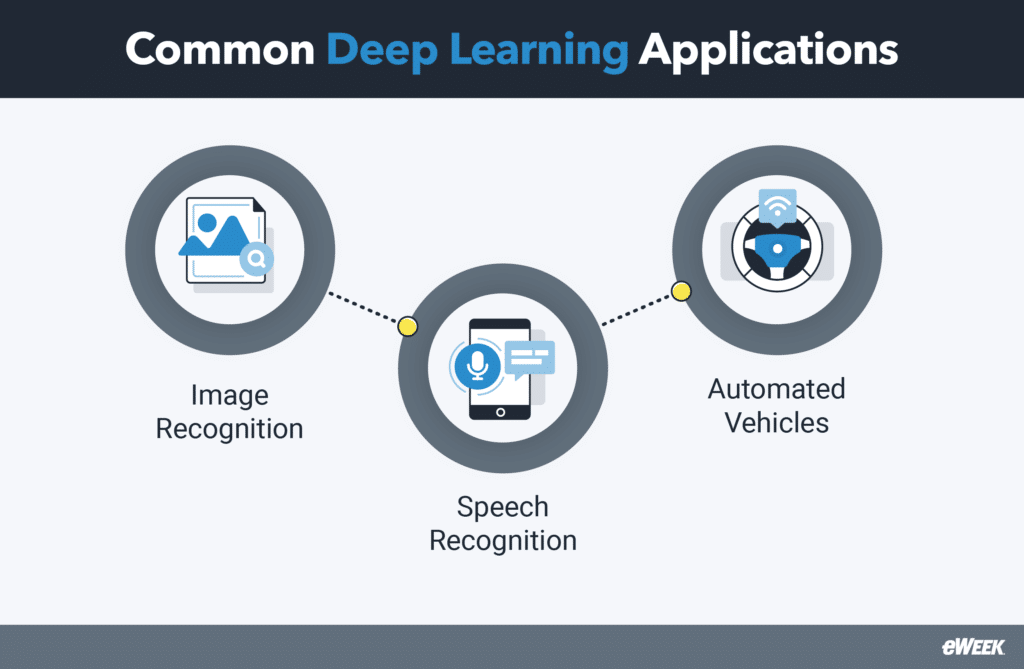 Deep studying is often utilized in picture recognition, speech recognition, and automatic automobiles.
Deep studying is often utilized in picture recognition, speech recognition, and automatic automobiles.
- Picture Recognition: Deep studying, and CNNs particularly, is utilized in object recognition, picture labeling, and textual content detection. It’s a precious characteristic for safety monitoring and monitoring automobiles in surveillance footage. Deep studying software program like Google Lens and Amazon Rekognition use CNNs to establish pictures in real-time.
- Speech Recognition: This refers to a system’s means to accurately translate spoken language into textual content in real-time. Speech recognition is beneficial in aiding college students with studying disabilities, like dyslexia, by permitting them to dictate their ideas with out being slowed down by the bodily act of writing. Instruments like Google’s Speech-to-Textual content AI and Speechmatics use deep studying for voice-to-text translation.
- Automated Autos: Deep studying powers the article detection and trajectory planning of self-driving automobiles. The AI processes knowledge from the automobile’s surroundings by way of cameras or GPS methods. Autonomous driving corporations like Tesla and Waymo use CNNs of their self-driving automobile methods.
Professionals and Cons of Deep Studying
It’s necessary to have an entire understanding of the professionals and cons of deep studying to know how you can successfully apply the know-how to totally different domains. The most typical benefits of deep studying embrace the next:
- Discovering Advanced Patterns: Deep studying usually surpasses people in picture classification or speech recognition, particularly when used on giant datasets.
- Studying from Uncooked Knowledge: By mechanically studying key options from uncooked knowledge, deep studying reduces the necessity for handbook characteristic engineering.
- Repeatedly Bettering: The character of deep studying implies that it always improves with ongoing analysis and developments.
The most typical disadvantages of deep studying embrace the next:
- Wants A number of Knowledge: Deep studying fashions want huge quantities of labeled knowledge to carry out nicely, which could be costly or troublesome to acquire.
- Strains Sources: Coaching these fashions requires important computational energy and time.
- Underperforms in Some Conditions: Overfitting continues to be a chance in coaching deep coaching fashions, when the system memorizes the coaching knowledge reasonably than studying generalizable patterns—this results in poor efficiency on new knowledge inputs.
What’s Generative AI?
GenAI is a subset of deep studying targeted on producing new and unique content material with human-like creativity. Like deep studying, it makes use of machine studying–however for creating new items of content material reasonably than knowledge evaluation and making predictions.
Generally used for producing pictures, audio, textual content, movies, and code, generative AI fashions are sometimes educated on huge labeled and unlabeled datasets by way of unsupervised and semi-supervised studying strategies for creating new outputs.
How Does it Work?
The generative AI system processes the textual content immediate, picture, or different enter and converts it right into a format that it could possibly work with. Then, the neural community analyzes this encoded enter for context. Based mostly on the processed enter, the AI system generates unique output till the ultimate content material is full.
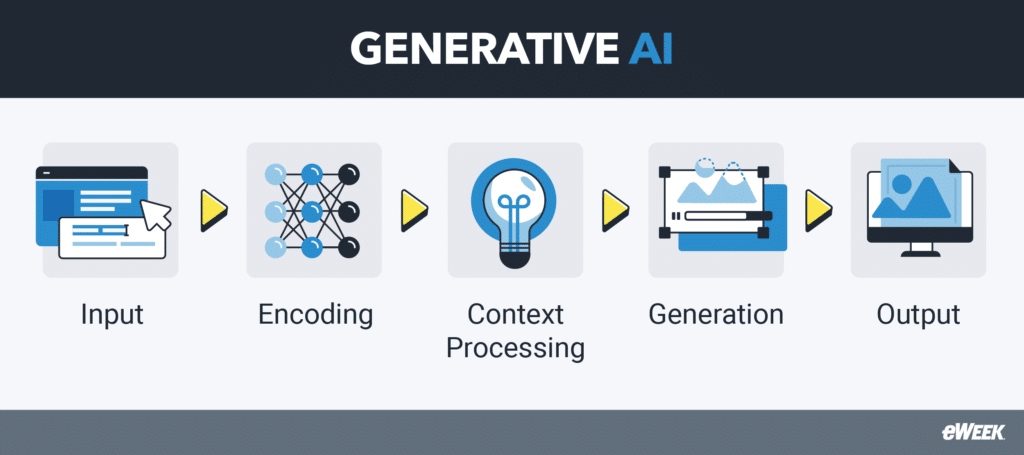 Within the generative AI course of, the consumer gives enter knowledge, which is encoded and processed for context, resulting in era of insightful output.
Within the generative AI course of, the consumer gives enter knowledge, which is encoded and processed for context, resulting in era of insightful output.
Strategies Utilized in Generative AI
GenAI instruments use numerous strategies to be taught from coaching knowledge and create new, novel content material that shares related options and traits. The precise strategies information the AI to interpret the underlying knowledge patterns and use that data to generate unique outputs. The next are essentially the most generally used strategies:
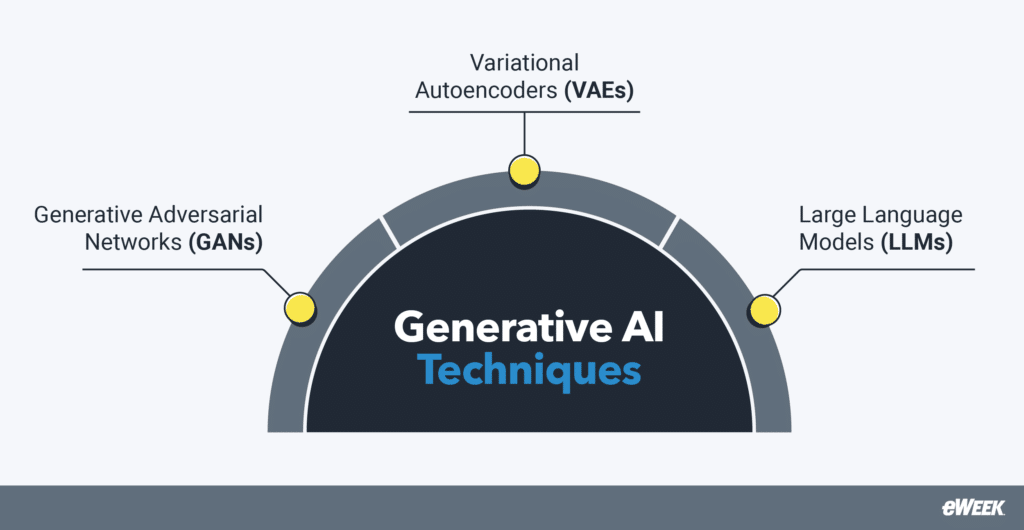 Widespread generative AI strategies embrace generative adversarial networks (GANs), variational autoencoders (VAEs), and enormous language fashions (LLMs).
Widespread generative AI strategies embrace generative adversarial networks (GANs), variational autoencoders (VAEs), and enormous language fashions (LLMs).
- Generative Adversarial Networks (GANs): These use a aggressive course of between two neural networks, a generator and a discriminator, to progressively enhance the realism of the generated outputs. The generator creates new content material, whereas the discriminator evaluates its high quality. As these networks compete, the generator learns to supply extra life like outputs. GANs are perfect for making highly-realistic pictures.
- Variational Autoencoders (VAEs): As an alternative of a aggressive method, variational autoencoders (VAEs) compress the coaching knowledge into low-dimensional latent-space. These then use this latent house to generate new samples that seize the basic patterns within the unique knowledge. This method is nice for producing textual content, music, and animations.
- Giant Language Fashions (LLMs): Giant Language Fashions (LLMs) are educated on giant volumes of textual content knowledge to be taught human language patterns and constructions. When given a immediate, LLMs can generate new textual content outputs, similar to tales, articles, or dialogues that mirror the human-like traits of the coaching knowledge. This makes LLMs appropriate for content material creation or constructing chatbots.
Generative AI Purposes
GenAI methods have the power to supply outputs that transcend easy retrieval or recombination of present info. They’ll generate artistic content material throughout a variety of domains, from literature to artwork. The next are a number of the most generally used functions:
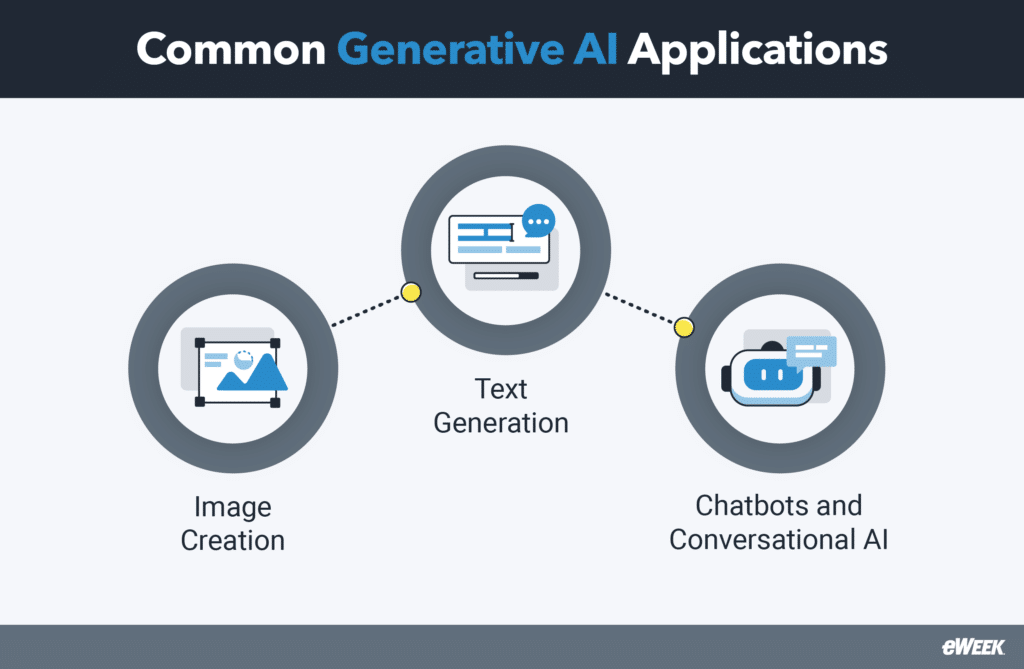 Generative AI is utilized in picture creation, textual content era, and chatbots and conversational AI.
Generative AI is utilized in picture creation, textual content era, and chatbots and conversational AI.
- Picture Creation: GenAI fashions can remodel easy textual content descriptions into high-quality, photorealistic pictures. This enables for brand spanking new potentialities for fast prototyping, product visualization, anc artistic expression with out handbook illustration or images. DALL-E 2 and Steady Diffusion are two of the well-known GenAI methods for picture creation.
- Textual content Era: Generative AI can be streamlining written content material creation by composing human-like textual content primarily based on easy enter prompts. Pure language processing (NLP) helps GenAI fashions interpret language context and constructions, after which craft new textual content that mimics human-written content material. Writesonic and Anthropic’s Claude are superior AI instruments for writing and textual content era.
- Chatbots and Conversational AI: Fashionable chatbots and digital assistants depend on GenAI, particularly LLMs, to interact in pure conversations and reply to follow-up questions. AI-powered chatbots can deliver genuine conversational experiences to finish customers. ChatGPT and Replika are prime examples of instruments that use GenAI to interact in human-sounding conversations.
Benefits and Disadvantages of Generative AI
Like deep studying, GenAI has its strengths and weaknesses which might be crucial to know to make sure accountable and efficient use.
The most typical benefits of generative AI embrace the next:
- Producing Photographs: GenAI fashions can generate detailed textual content and lifelike pictures that may be indistinguishable from human-created content material.
- Inspiring Concepts: Whereas human creativity stays unmatched, GenAI can assist spark new concepts and discover novel ideas which will encourage artistic work.
- Streamlining Environment friendly Content material: GenAI instruments can considerably speed up the content material creation course of, permitting writers and digital entrepreneurs to supply high-quality textual content and pictures with better velocity and effectivity.
The next are the commonest disadvantages of generational AI:
- Potential for Bias: AI-generated textual content and pictures can mirror biases and inaccuracies current within the coaching knowledge. This may occasionally trigger propagation of misinformation or inappropriate content material.
- Moral Considerations: Utilizing GenAI for content material creation raises necessary moral considerations, together with influence on human jobs, and copyright, mental property, and privateness points.
- Will be Misused: GenAI’s means to create highly-realistic pictures can result in considerations on potential for misuse, similar to creating deepfakes or unfold of misinformation.
3 Introductory Programs to Be taught Extra
Studying the fundamentals of generative AI is necessary to develop a stable comprehension of the know-how—particularly at the moment, when AI continues to reshape industries and domains. We’ve curated an inventory of three introductory programs that cowl the important thing ideas of GenAI.
Udemy: Generative AI for Freshmen
The Generative AI for Freshmen course on Udemy delivers a complete introduction to generative AI for freshmen. Created by Aakriti E-Studying Academy, this course has seven lectures and 27 lectures masking subjects like LLMs, immediate engineering, and real-world GenAI functions. The course prices $24.99 and goals to construct sensible abilities, similar to making a chatbot. No prior AI data or coaching is important to enroll.
Go to Generative AI for Freshmen on Udemy
Coursera: Introduction to Generative AI
Introduction to Generative AI on Coursera is a microlearning course from Google that gives a beginner-friendly exploration of generative AI fundamentals. It discusses key topics like defining GenAI, the way it works, mannequin varieties, and real-world functions. A subscription to Coursera Plus for $59 per 30 days is important to enroll on this starter course, which is a part of the broader Introduction to Generative AI Studying Path Specialization sequence. No prior AI expertise is required.
Go to Introduction to Generative AI on Coursera
Coursera: Generative AI Introduction and Purposes
Generative AI: Introduction and Purposes on Coursera from IBM brings an summary of generative AI for freshmen. It tackles GenAI capabilities for producing textual content,pictures, code, speech, and video. This course examines AI fashions and instruments, in addition to real-life makes use of of the know-how in numerous sectors, together with IT, leisure, and healthcare industries. It’s appropriate for anybody occupied with maximizing the potential of GenAI of their private {and professional} endeavors. You want to subscribe to Coursera Plus for $59 per 30 days to entry this course.
Go to Generative AI: Introduction and Purposes on Coursera
Backside Line: Selecting Purposes for Deep Studying vs Generative AI
Whereas each deep studying and generative AI supply highly effective capabilities, they specialise in totally different areas and have distinct strengths and weaknesses. Distinguishing the variations between these two branches of AI is important to find out which method is finest suited in your necessities.
It’s necessary to notice that deep studying and generative AI aren’t immediately comparable, as they serve totally different functions and function in district methods. Deep studying is finest for duties that decision for studying advanced patterns to categorise, establish, or make predictions about an enter. In distinction, GenAI is good for crafting content material, from human-like textual content to life like pictures. The selection between these applied sciences will depend on your particular targets. By figuring out the nuances of every method, you can also make knowledgeable choices.
Dive into our complete article on Neural Networks vs. Deep Studying and establish the proper know-how in your wants.

